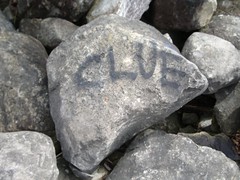Writing Wednesday returns this . . . well, Wednesday!
Feel free to enjoy this song (which my littlest sister would call “really old”) while you read. It’s stuck in my head anyway, if you couldn’t guess from the title.
As we’re burying our clues it’s important to remember that mysteries are central to stories in every genre. As Nathan Bransford points out, mysteries are what keep us reading (emphasis mine):
When it comes to crafting a mystery, I think sometimes aspiring authors get distracted by the bodies and murders and the actual plot mechanics of mysteries, and miss what really drives a great mystery.
Mysteries are about people. And more specifically, they’re about people wanting something, whether it’s an object, person, or knowledge (see also: Do You Know What Your Characters Want?). The character wants the woman to fall in love with him or to catch the killer or find the truth about what happened. We keep reading to find out if they’re going to get it.
Here comes the word math:
A character’s desire + Consequences/stakes + Obstacles + Delay = Mystery
Getting too caught up in the clues and how exactly to bury them isn’t something we need to worry about as we’re brainstorming, outlining, or even writing our first draft. (Unless, of course, you have a brilliant idea during any of those processes—then use it!) The fine work of layering in just enough but not too many clues requires practice, patience and critique partners.
But beyond all that, we have to keep in mind that the real key to mystery, and to suspense in any story is to keep our readers guessing about whether the protagonist will get what s/he wants.
This concludes our series on clues in non mysteries!
What do you think? What are the most important elements of a mystery to you?

